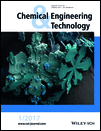Carbon Membranes Prepared from a Polymer Blend of Polyethylene Glycol and Polyetherimide
Corresponding Author
Wan Nurul Huda Wan Zainal
School of Chemical Engineering, Universiti Sains Malaysia, Nibong Tebal, Penang, Malaysia.
Faculty of Engineering Technology, Universiti Malaysia Pahang, Kuantan, Pahang, Malaysia.
School of Chemical Engineering, Universiti Sains Malaysia, Nibong Tebal, Penang, Malaysia.Search for more papers by this authorSoon Huat Tan
School of Chemical Engineering, Universiti Sains Malaysia, Nibong Tebal, Penang, Malaysia.
Search for more papers by this authorMohd Azmier Ahmad
School of Chemical Engineering, Universiti Sains Malaysia, Nibong Tebal, Penang, Malaysia.
Solid Waste Management Cluster, Science and Engineering Research Centre, Universiti Sains Malaysia, Nibong Tebal, Penang, Malaysia.
Search for more papers by this authorCorresponding Author
Wan Nurul Huda Wan Zainal
School of Chemical Engineering, Universiti Sains Malaysia, Nibong Tebal, Penang, Malaysia.
Faculty of Engineering Technology, Universiti Malaysia Pahang, Kuantan, Pahang, Malaysia.
School of Chemical Engineering, Universiti Sains Malaysia, Nibong Tebal, Penang, Malaysia.Search for more papers by this authorSoon Huat Tan
School of Chemical Engineering, Universiti Sains Malaysia, Nibong Tebal, Penang, Malaysia.
Search for more papers by this authorMohd Azmier Ahmad
School of Chemical Engineering, Universiti Sains Malaysia, Nibong Tebal, Penang, Malaysia.
Solid Waste Management Cluster, Science and Engineering Research Centre, Universiti Sains Malaysia, Nibong Tebal, Penang, Malaysia.
Search for more papers by this authorAbstract
Through a dip-coating technique, carbon membranes were produced from a polymer blend consisting of the thermally stable polymer polyetherimide (PEI) and the thermally labile polymer polyethylene glycol (PEG). The PEG/PEI carbon membranes were synthesized on an alumina support coated with an Al2O3 intermediate layer. The polymer blend ratio and carbonization temperature influenced the structure and permeation performance of the derived carbon membranes. The porosity of the PEG/PEI carbon membranes increased with higher PEG content in the blends. However, the derived carbon membranes tended to lose gas permeability with raising the carbonization temperatures. The carbon membranes were successfully optimized in order to achieve the highest CO2/CH4 and CO2/N2 selectivities.
References
- 1 M. Das, J. D. Perry, W. J. Koros, Carbon 2010, 48, 3737–3749. DOI: 10.1016/j.carbon.2010.06.036
- 2 Y. K. Kim, H. B. Park, Y. M. Lee, J. Membr. Sci. 2004, 243, 9–17. DOI: 10.1016/j.memsci.2004.05.001
- 3 B. Zhang, T. Wang, S. Liu, S. Zhang, J. Qiu, Z. Chen, H. Cheng, Microporous Mesoporous Mater. 2006, 96, 79–83. DOI: 10.1016/j.micromeso.2006.06.025
- 4 B. Zhang, G. Shen, Y. Wu, T. Wang, J. Qiu, T. Xu, C. Fu, Ind. Eng. Chem. Res. 2009, 48, 2886–2890. DOI: 10.1021/ie8013583
- 5 J. Ozaki, N. Endo, W. Ohizumi, K. Igarashi, M. Nakahara, A. Oya, Carbon 1997, 35, 1031–1033. DOI: 10.1016/S0008-6223(97)89878-8
- 6 X. Zhang, H. Hu, Y. Zhu, S. Zhu, J. Membr. Sci. 2007, 289, 86–91. DOI: 10.1016/j.memsci.2006.11.047
- 7 W. N. W. Salleh, A. F. Ismail, Sep. Purif. Technol. 2011, 80, 541–548. DOI: 10.1016/j.seppur.2011.06.009
- 8 P. S. Rao, M. Y. Wey, H. H. Tseng, I. A. Kumar, T. H. Weng, Microporous Mesoporous Mater. 2008, 113, 499–510. DOI: 10.1016/j.micromeso.2007.12.008
- 9 W. N. W. Salleh, A. F. Ismail, Sep. Purif. Technol. 2012, 88, 174–183. DOI: 10.1016/j.seppur.2011.12.019
- 10 A. K. Itta, H. H. Tseng, M. Y. Wey, J. Membr. Sci. 2011, 372, 387–395. DOI: 10.1016/j.memsci.2011.02.027
- 11 S. S. Hosseini, M. R. Omidkhah, A. Z. Moghaddam, V. Pirouzfar, W. B. Krantz, N. R. Tan, Sep. Purif. Technol. 2014, 122, 278–289. DOI: 10.1016/j.seppur.2013.11.021
- 12 H. Hatori, T. Kobayashi, Y. Hanzawa, Y. Yamada, Y. Ilmura, T. Kimura, M. Shiraishi, J. Appl. Polym. Sci. 2000, 79, 836–841. DOI: 10.1002/1097-4628(20010131)79:5<836::AID-APP80>3.0.CO;2-1
- 13 S. S. Hosseini, T. S. Chung, US Patent 0192281 A1, 2011.
- 14 Y. K. Kim, H. B. Park, Y. M. Lee, J. Membr. Sci. 2005, 251, 159–167. DOI: 10.1016/j.memsci.2004.11.011
- 15 P. S. Tin, Y. Xiao, T. S. Chung, Sep. Purif. Rev. 2006, 35, 285–318. DOI: 10.1080/15422110601003481
- 16 Y. Kobayashi, T. Ishizaka, Y. Kurokawa, J. Mater. Sci. 2005, 40, 263–283. DOI: 10.1007/s10853-005-6080-8
- 17 B. Zhang, Y. Shi, Y. Wu, T. Wang, J. Qiu, J. Appl. Polym. 2014, 131, 39925. DOI: 10.1002/APP.39925
- 18 A. C. Lua, J. Su, Carbon 2006, 44, 2964–2972. DOI: 10.1016/j.carbon.2006.05.028
- 19 C. T. Song, T. Wang, Y. Qiu, J. Qiu, H. Cheng, J. Porous Mater. 2009, 16, 197–203. DOI: 10.1007/s10934-008-9185-z
- 20 S. Liu, T. Wang, Q. Liu, S. Zhang, Z. Zhao, C. Liang, Ind. Eng. Chem. Res. 2008, 47, 876–880. DOI: 10.1021/ie0707341
- 21 R. K. Mariwala, H. C. Foley, Ind. Eng. Chem. Res. 1994, 33, 607–615. DOI: 10.1021/ie00027a018
- 22 M. Yoshimune, I. Fujiwara, K. Haraya, Carbon 2007, 45, 553–560. DOI: 10.1016/j.carbon.2006.10.017
- 23 L. M. Robeson, J. Membr. Sci. 2008, 320, 390–400. DOI: 10.1016/j.memsci.2008.04.030
- 24 X. He, J. A. Lie, E. Sheridan, M. B. Hagg, Ind. Eng. Chem. Res. 2011, 50, 2080–2087. DOI: 10.1021/ie101978q
- 25 B. Zhang, Y. Wu, T. Wang, J. Qiu, J. Appl. Polym. Sci. 2011, 122, 1190–1197. DOI: 10.1002/app.34261
- 26 K. Briceno, D. Montane, R. Garcia-Valls, A. Iulianelli, A. Basile, J. Membr. Sci. 2012, 415–416, 288–297. DOI: 10.1016/j.memsci.2012.05.015
- 27 L. Li, C. Wang, N. Wang, Y. Cao, T. Wang, J. Mater. Sci. 2015, 50, 2561–2570. DOI: 10.1007/sl0853-015-8819-1
- 28 B. Zhang, Y. Shi, Y. Wu, T. Wang, J. Qiu, J. Appl. Polym. Sci. 2014, 1–10. DOI: 10.1002/APP.39925
- 29 M. Teixeira, M. Campo, D. A. Tanaka, M. A. Tanco, C. Magen, A. Mendes, Chem. Eng. Res. Des. 2012, 90, 2338–2345. DOI: 10.1016/j.cherd.2012.05.016
- 30 H. H. Tseng, P. T. Shiu, Y. S. Lin, Int. J. Hydrogen Energy 2011, 36, 15352–15363. DOI: 10.1016/j.ijhydene.2011.08.060




